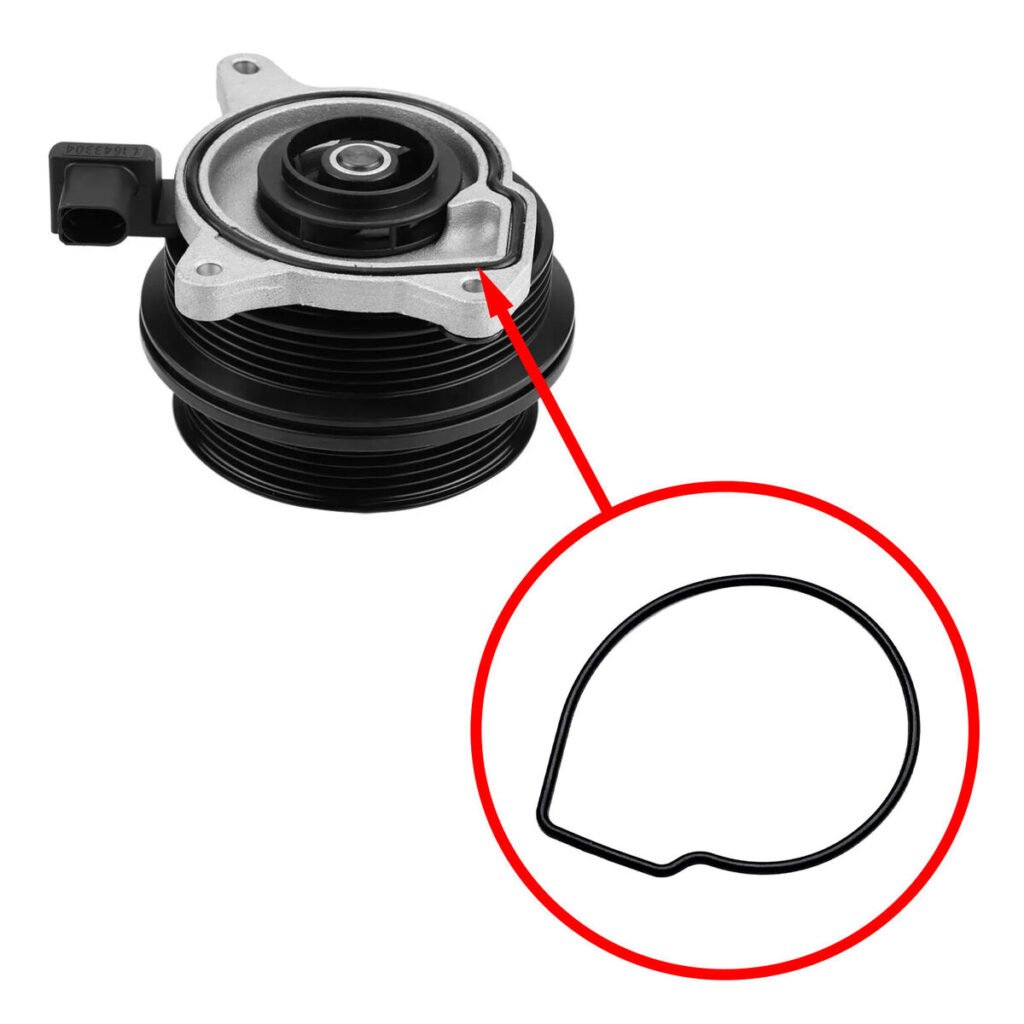
what is Water pump gasket?
A water pump gasket is a precision-sealing component placed between the water pump housing and the engine block (or timing cover). It plays a critical role in sealing the coolant pathway while preventing leaks that could disrupt the cooling system’s functionality.
Modern vehicles demand more durable and technologically advanced gaskets, as engines operate under higher pressure, higher temperatures, and tighter tolerances.
Materials Used in Water Pump Gaskets
- Multi-Layer Steel (MLS):
- Description: These are made of multiple layers of thin steel with an elastomer coating for improved sealing.
- Benefits:
- High resistance to temperature and pressure variations.
- Superior strength for turbocharged or high-performance engines.
- Reusable in some cases.
- Application: Widely used in modern high-compression or turbocharged engines.
- Thermoplastic Elastomers (TPE):
- Description: These advanced polymers are highly flexible and resistant to wear.
- Benefits:
- Lightweight and eco-friendly.
- Excellent thermal stability.
- Commonly molded directly into water pumps, reducing the need for a separate gasket.
- Graphite Composite:
- Description: A mix of graphite and other advanced fibers bonded to a metallic core.
- Benefits:
- Resistant to extreme temperatures (used in hybrid and EV cooling systems).
- Seals effectively even with imperfect mating surfaces.
- Silicone-Based Gaskets:
- Description: Made from heat-resistant silicone material, either as standalone gaskets or as a bead applied on the pump housing.
- Benefits:
- Very flexible and easy to apply.
- Often used in hybrid or electric vehicles, where cooling efficiency is crucial.
Latest Technologies in Water Pump Gasket Design
- Integrated Gasket Design:
- Some modern water pumps have gaskets integrated directly into the pump housing during manufacturing.
- Advantage:
- Reduces the chances of misalignment during installation.
- Simplifies the assembly process.
- Liquid Gaskets (Sealants):
- In place of traditional gaskets, manufacturers now use liquid RTV (Room-Temperature Vulcanizing) silicone sealants.
- Example: Honda Bond, Permatex Ultra Black, or Toyota FIPG.
- Advantage:
- Provides a custom-fit seal and fills in minor surface imperfections.
- Eliminates the need for pre-cut gaskets.
- Nanotechnology Coatings:
- Some high-end gaskets are coated with nano-scale lubricants or anti-corrosion materials to resist wear and improve lifespan.
- Benefit: Reduces friction and improves sealing in extreme conditions.
- Hybrid Cooling Systems Compatibility:
- Gaskets are now engineered to handle the dual cooling circuits in hybrid and electric vehicles (EVs), where both battery and engine components require precise cooling.
- 3D Printing of Gaskets:
- High-performance automotive manufacturers are starting to 3D-print gaskets for custom applications.
- Advantage:
- Rapid prototyping for performance tuning.
- Tailored fit for unique engine designs.
Signs of a Failing Water Pump Gasket
With advancements in technology, identifying gasket failures is easier using these modern methods:
- Coolant Leak Detection:
- UV Dye Testing: A UV-reactive dye is added to the coolant. A UV light highlights the source of leaks, including the water pump gasket.
- Thermal Imaging Cameras: These detect hotspots caused by coolant leaks or poor sealing.
- Digital Pressure Testing Tools:
- Traditional pressure testers are now equipped with digital sensors to monitor pressure loss more accurately.
- OBD-II Integration (Smart Cooling System Alerts):
- Modern vehicles monitor coolant temperature and pressure electronically. A failing water pump gasket can trigger fault codes related to cooling performance.
Water Pump Gaskets in EVs and Future Trends
The rise of electric vehicles (EVs) has shifted the design and functionality of cooling systems, including water pump gaskets:
- Thermal Management in EVs:
- EVs use liquid-cooled battery systems, requiring highly efficient seals.
- Gaskets are now designed to seal not just high temperatures but also the chemical coolant solutions used in battery cooling (e.g., glycol-based coolants).
- Active Cooling Systems in EVs:
- Modern EVs feature multiple independent cooling loops for motors, inverters, and batteries. Gaskets are specialized to handle the different operating conditions.
- Self-Healing Gaskets:
- In development are gaskets made with materials that can self-repair small cracks or abrasions, reducing maintenance.
- Eco-Friendly Materials:
- Automakers are adopting biodegradable or recyclable gasket materials to reduce environmental impact.
Steps for Installation
- Preparation:
- Scan the Cooling System: Use OBD-II diagnostics or a thermal scanner to confirm the issue is gasket-related.
- Drain the coolant entirely to prevent contamination.
- Surface Cleaning:
- Use rotary gasket removers or abrasive pads designed not to damage aluminum surfaces.
- Advanced Sealant Application (if required):
- Apply modern RTV or anaerobic sealants where specified. Avoid over-application, as it can clog coolant passages.
- Precise Torqueing:
- Use a digital torque wrench to ensure bolts are tightened to exact specifications, avoiding uneven compression.
- System Calibration:
- After reassembly, use advanced coolant bleeding systems to ensure all air pockets are removed, especially in EVs and hybrids with complex cooling paths.
Pro Technician Tips
- Use Manufacturer-Specified Parts and Sealants: Always stick to OEM recommendations to ensure compatibility.
- Replace Bolts if Necessary: Some water pump bolts are single-use and stretch when tightened.
- Test Before Driving: After installation, pressurize the system to verify the seal integrity before returning the vehicle to the customer.
0件のコメント